
What is really important, it is better to do it myself so thought Adolf Hitler. “The führer had carefully adjusted the draft Directive No. 41 and complements its essential, drawn up by himself, partitions, fixed 5 April 1942 Colonel General staff Walter Scherf. — The most important part relating to the main operation, was again drawn up by the Fuehrer.” Further Scherf ordered to record in the war diary of his military history Department of the Wehrmacht high command: “the Code word for the main operation “Siegfried” was changed to “Blau””.
What changed Hitler, it is not known how and what was the project staff of the operational management of the armed forces in those places, which, apparently, did not like the Supreme commander of the Third Reich. The original is in Germany no longer to find; the question of the possibility of finding among the archives of the trophies of the red army, which is currently processed gradually in Russia, was opened.
The result, anyhow, was clear. The aim of German planning in 1942 it was completely destroyed “the remaining live military force of the Soviet Union and to remove him from the most important sources of military and economic power as far as I could”. To achieve this goal, should “adhere to the original goals of the Eastern campaign” in the North to conquer Leningrad, and “on the southern flank of the army front to force a breakthrough to the Caucasus”.
This meant a complete rejection of the plan “Barbarossa”, on the basis of which on 22 June 1941, the Wehrmacht attacked the Soviet Union, even if the Directive was the reverse. Initially, the first plan was the conquest of Moscow. Directive No. 41 had ordered now that the summer offensive was to be held “by forces of group of armies “Centre””.
In the end Hitler also knew that the strength of his army are limited. Since the goal with the resources available to the transport capacity can be achieved “only in parts”, the main effort of the operation was to be applied first in the South. The goal was “to destroy the enemy before the Don, and then to conquer the oil fields of the Caucasus and the Caucasian passes”. The final storming of the blocked Leningrad were to be carried out only when a sufficient number of troops will be ready.
The result of this Directive was the summer offensive of the Germans in 1942, and it is the plan “Blau”. The second attempt of Hitler to defeat his former ally Stalin with the help of the blitzkrieg. At Moscow’s first attempt in November of 1941 bogged down, as weather conditions prevented the German army.
Hitler dreamed of a Grand battle
Such threats, while promoting further South did not exist. Nothing hurt, if to launch an attack before November, as the weather in the distant steppes between Kuban, Don and Volga is not so extreme as Moscow (and, of course, near Leningrad).
On the Desk of the chief of staff planned the operation looked good: first, the German second army, which formed the Northern flank of army group South, was to capture the industrial city on the don, Voronezh, and then to move along the river to the Southeast. At the same time had to be cut Soviet arc front near the town of Raisins.
To further weaken the Red army, Hitler had planned a huge battle at the end of the summer of 1941. For this sixth army and first Panzer army was to advance from Kharkov directly to the East, in the direction of Stalingrad, which was also on the Volga. Here was to meet the Northern and Central parts of the operation. All the enemy troops would then be surrounded on the West of the Volga and the don; they had to be destroyed or forced to surrender.
Meanwhile the German 17th army was to come through growth in the direction of the Caucasus. In the Directive the ultimate aim of this offensive, the oil fields near Maikop and Grozny, and Baku on the Caspian sea, was designated only by a hint.
In order to have maximum offensive power, Hitler wanted to provide as many German units to use as wedges, while protecting the flanks, primarily along the don, were backed by Italian, Romanian and Hungarian troops. But they were worse armed, hardly had the tanks and therefore had a low military value. Only in particularly vulnerable places of the German units were to be used as support allies. This calculation led to serious consequences in the battle for Stalingrad.
In April 1942, the Commander of the troops began the implementation of Directive No. 41 — first group of reinforcements from the homeland. Instead 108450 human losses, 60291 of them are combat losses (dead and wounded), moved 121400 people. While the Central army group received 45,1 thousand recruits to replace their losses of 46.2 thousand people, the reinforcement of the southern group of forces was much more serious: 52.8 thousand people for a change 23 thousands of human losses. In fact, the southern group of forces was reinforced by two full divisions.
However, these figures misled. As of March 30, 1942, out of 162 German divisions on the Eastern front, only eight were good “for completing all tasks.” 50 was only conditionally able to attack, mainly “suited for a limited range of offensive tasks,” as established by the General staff of the army. According to this internal “assessment of combat forces” for the defense were good 73 division. The other 29 only partially able to perform even this task.
Only a good third of the Eastern troops were at least partially satisfactory, equipped with soldiers and equipment to attack targets according to plan “Blau”. In comparison with the specified parameters of the Wehrmacht before operation on the Eastern front was missing more than 2 thousand tanks, nearly 70 thousand trucks and cars as well as motorcycles 44087, which is especially important for rapid-onset. Directive No. 41, revised personally by Hitler was something of a plan for almost sure defeat.







